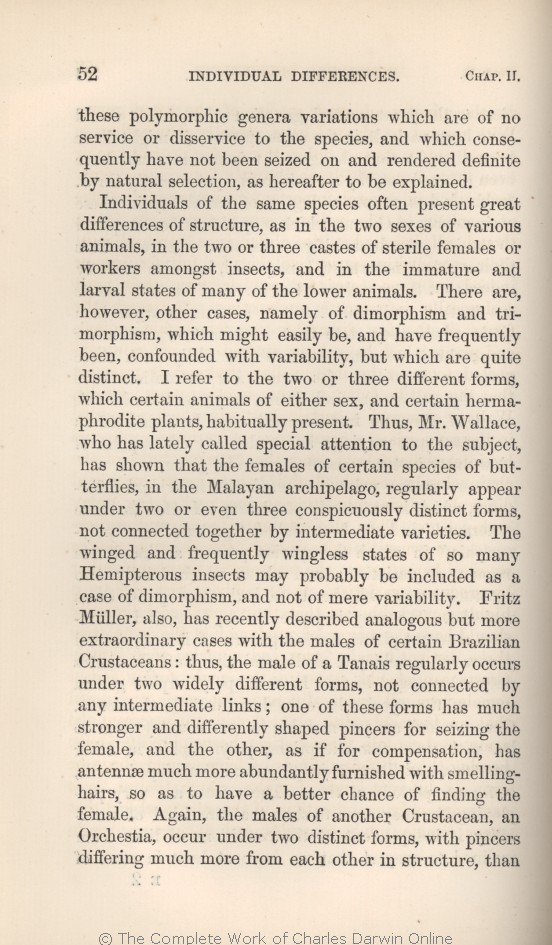Individuals of the same species often
present | present 1866 1869 | | present, 1872 |
| great 1866 1869 |
| as is known to every one, great 1872 |
| OMIT 1869 |
| not directly connected with variability, 1866 |
| independently of variation, 1872 |
| sexes 1869 1872 | | sexes, 1866 |
| of various animals, 1869 1872 |
| as 1866 |
| many of the lower 1869 1872 |
| all 1866 |
| however, other cases, namely 1866 1869 |
| also, cases 1872 |
| which might easily be, and have frequently been, confounded with variability, but which are quite distinct. 1869 |
| which might easily be, and have frequently been, confounded with variability, but which are really quite distinct. 1866 |
| both with animals and plants. 1872 |
| different 1869 | | distinct 1866 |
| special 1866 1869 | special 1872 |
| together 1866 1869 | together 1872 |
| Müller, also, has recently 1866 1869 |
| Müller has 1872 |
| widely different forms, not connected by any intermediate links; 1866 1869 |
| distinct forms; 1872 |
| forms 1866 1869 | forms 1872 |
| stronger 1866 1869 | | strong 1872 |
| pincers 1866 1869 | | pincers, 1872 |
| for seizing the female, 1866 1869 |
| OMIT 1872 |
| other, 1866 1869 | | other 1872 |
| as if for compensation, 1866 1869 |
| OMIT 1872 |
| smelling-hairs, 1866 1869 | | smelling-hairs. 1872 |
| better 1866 1869 | better 1872 |
| chance 1866 1869 | chance 1872 |
| finding 1866 1869 | finding 1872 |
| female. 1866 1869 | female. 1872 |
| 6 blocks not present in 1859 1860 1861 1866 1869; present in 1872 | | Although in most of these cases, the two or three forms, both with animals and plants, are not now connected by intermediate gradations, it is probable that they were once thus connected.
Mr. Wallace, for instance, describes a certain butterfly which presents in the same island a great range of varieties connected by intermediate links, and the extreme links of the chain closely resemble the two forms of an allied dimorphic species inhabiting another part of the Malay archipelago.
Thus also with ants, the several worker-castes are generally quite distinct; but in some cases, as we shall hereafter see, the castes are connected together by finely graduated varieties.
So it is, as I have myself observed, with some dimorphic plants.
It certainly at first appears a highly remarkable fact that the same female butterfly should have the power of producing at the same time three distinct female forms and a male; and that an hermaphrodite plant should produce from the same seed-capsule three distinct hermaphrodite forms, bearing three different kinds of females and three or even six different kinds of males.
Nevertheless these cases are only exaggerations of the common fact that the female produces offspring of two sexes which sometimes differ from each other in a wonderful manner.
|
|









